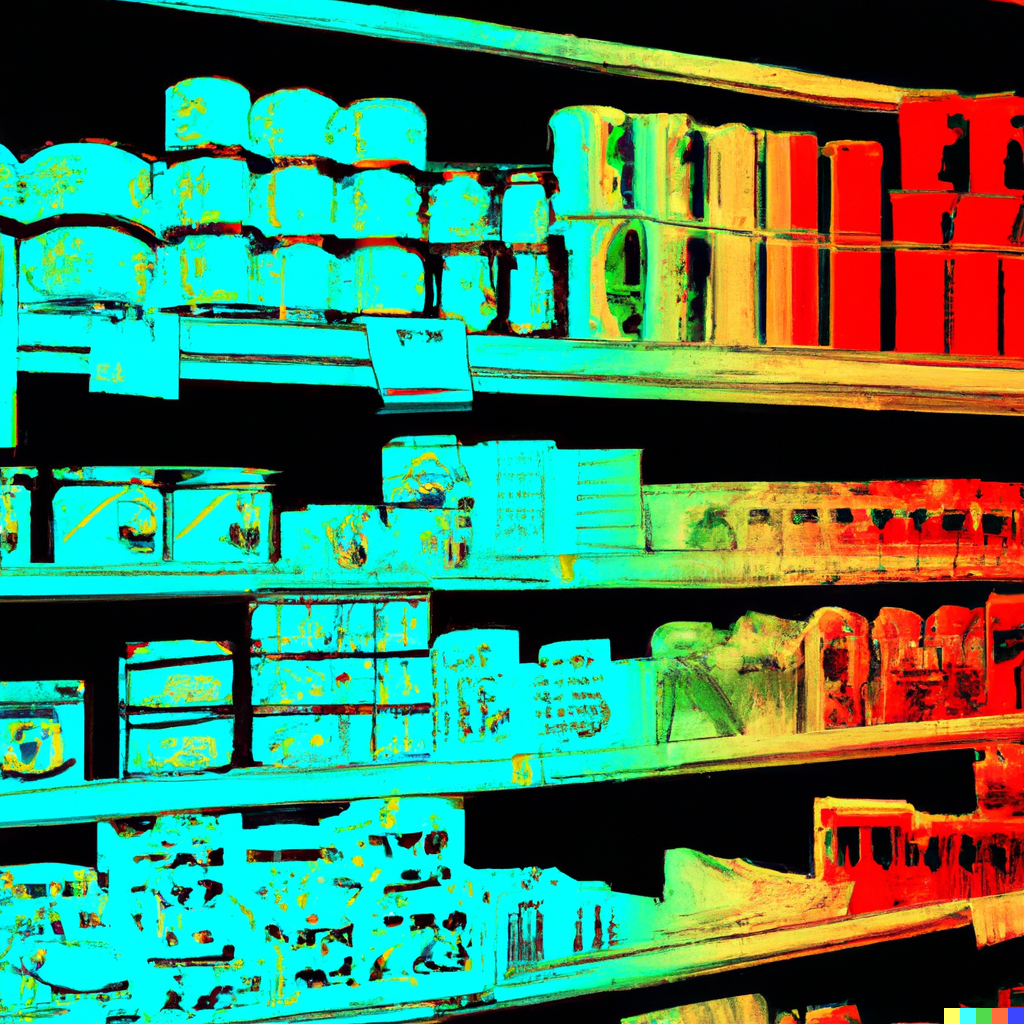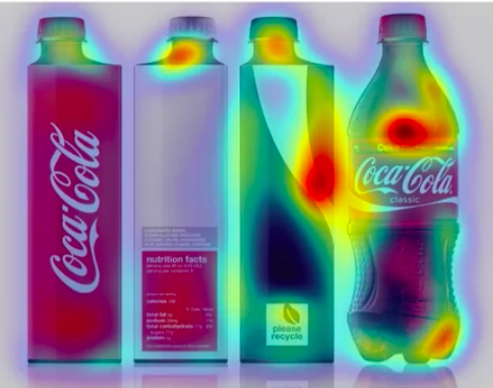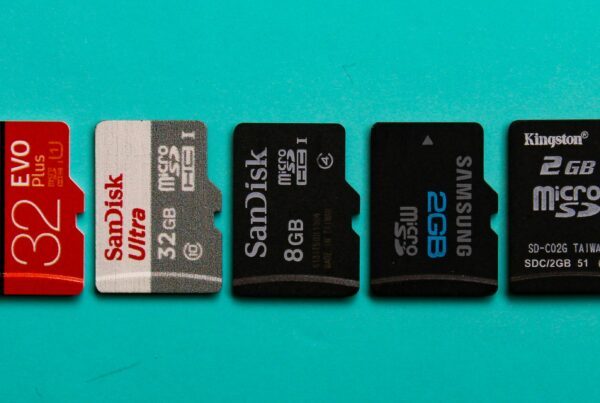
Imagine a tool that can predict where your eyes will look before you even see an image. Sounds like something out of a sci-fi movie, right? Well, meet Predict, an algorithm that’s changing the game for brands by predicting how well their products capture the attention of customers.
Imagine a tool that can predict where your eyes will look before you even see an image. Sounds like something out of a sci-fi movie, right? Well, meet Predict, an algorithm that’s changing the game for brands by predicting how well their products capture the attention of customers.

Photo created by Shriya Bang with the assistance of DALL·E

Photo created by Shriya Bang with the assistance of DALL·E
Some decades ago, neuroscientist Benjamin Libet studied a simple hand movement, and found signals in the brain that precede, and thereby predict, our actions before we even decide to act. This contributed to an important understanding in consumer psychology that consumer behaviour is predictable, and that some human responses are shared. Take being startled by a jumpscare for example. Some of us are dramatic jumpers, others are quiet jumpers, but the behaviour itself is consistent. The next breakthrough in decision-making research was the emergence of machine learning and artificial intelligence. Along with the knowledge that our behaviour is predictable, we now had machines that could learn how humans behave. The subsequent step was to create computer programs that imitate our predictable behaviour – and we get something like Predict, a tool used today by brands like Coca Cola and Microsoft.
The marketing firm Neurons Inc. developed Predict, an algorithm that predicts human attention! Specifically, when you upload an image, it creates heat maps of the image that indicate exactly which areas will capture visual attention, and which areas will be neglected. You then get a report card of your image, with features like cognitive load, clarity, colour load, focus, engagement, complexity, and visual saliency scored from 0% to 100%. Brands designing websites, apps, advertisements and packaging for their products always have the same questions. What will customers pay attention to? Will they look at my logo? Will they focus on the price? Will they be able to process the relevant information? Will they remember the product? Simply uploading the product to Predict provides a clear evaluation within seconds.

The bottom line of this complex, magical contraption is a simple, basic principle: bottom-up attention. That is, attention which is automatically drawn to specific stimuli, like faces, text, contrast or a bright colour (Kastner & Ungerleider, 2000). This tendency of ours has turned today’s world into an “attention economy” (Simon, 1971). For instance, we only respond to ads that have ‘stopping power’- i.e. ads that grab our attention and sustain it. If we don’t pay attention to a product, we neither respond to it, nor remember it (The Advertising Research Foundation, n.d.). As Seth Godlin, author and marketing strategist, remarks, “in a busy marketplace, not standing out is the same as being invisible.”
Now, to ensure that a product has ‘stopping power’, companies can take the traditional marketing route and run eye tracking studies. However, this comes with a price tag that leaves many brands out. Predict offers an alternative that is more affordable, efficient, and effective, allowing brands to obtain valuable insights quickly and easily.
The algorithm is made up of two core components. One is a database of 500 million data points from eye tracking data of 12.000 people, among the world’s largest databases of consumer visual attention. The other is a machine learning approach with over 30 algorithms that have been tested simultaneously to produce the most predictive models.
While this is all very exciting, the crux is how these predictions compare to actual, real visual attention. Can we trust Predict to be accurate? Do we really attend to these specific areas that Predict predicts? Fortunately, the creators behind the algorithm asked themselves the same questions. They verified Predict by comparing its predictions to real eye tracking results. The correlation and error rate between the two revealed accuracy rates consistently over 91%. For a machine simulating complex human behaviour within seconds, this is an impressive feat.
Predict was also put to the test by showing the visual attention heatmap of an image to expert interpreters of eye-tracking data. They did not know if the map had been predicted by Predict, or if it was from a real person wearing eye-tracking glasses. Once again, the interpretations of the heat maps created by Predict were found to be ‘virtually identical’ to those of real human eyes! (Neurons Inc., 2020)
“The bottom line of this complex, magical contraption is a simple, basic principle: bottom-up attention.”
In the world of marketing, predicting consumer attention is a game changer for brands. Let’s take the case of fastPay, Turkey’s first digital wallet, who looked to enhance their designs and user experience. The marketing team at fastPay partnered with Predict, which is incorporated into Neuron Inc.’s ‘Predict AI’ service. The process was simple yet effective in optimising their product creatives i.e., the visual elements on the fastPay application, like graphics and images. They uploaded the product creatives onto Predict and received feedback in the form of scores on visual attention and cognitive load. The feedback helped the team make adjustments to the interface. For instance, if Predict gave a high cognitive load score, indicating that there was too much going on, then fastPay adjusted accordingly, by removing some extra load and clutter from the interface. They could score the creatives, adjust them, and have them live on the fastPay application quickly. The results were impressive, as user retention increased, bounce rates and complaints decreased by half, and click-struggle decreased by 45%. Additionally, clicks on banners and messages increased by 65% and in-app conversion rates rose by 55%. All of these improvements contributed to fastPay’s growing popularity and customer satisfaction. (If you’re curious to see the heatmaps that Predict predicted for fastPay’s creatives, check them out here!)
This case demonstrates how predictive AI serves both consumers and brands: a balance that takes traditional marketing blood, sweat and tears to achieve. Predict is a cutting-edge tool that demonstrates the growing intersection between cognitive neuroscience, computer vision, and marketing research. As the field of neuromarketing continues to evolve, we can expect to see more sophisticated algorithms and techniques being developed to help brands better understand and connect with their customers. Attention is only the beginning. New AI models are emerging, predicting emotional responses, memory, and ultimately choices. <<
References
– How NEOHUB increased fastPay’s click-through rates by 65% using predictive AI. (2023, March 9). Neurons | Predict Consumer Responses & Behavior https://www.neuronsinc.com/cases/neohub-fastpay-case-study
– Neurons Inc. (2020). NeuroVision technical report [Technical report]. NeuroVision. https://neurovisionapp.com/wp-content/uploads/2020/06/NeuroVision-Technical-report-2020.pdf
– NeuroVision – About. (n.d.). NeuroVision. Retrieved February 23, 2023, from https://neurovisionapp.com/about
– NeuroVision – Eye Tracking AI – Customer Attention Prediction. (n.d.). Go.neuronsinc.com. Retrieved February 23, 2023, from https://go.neuronsinc.com/en-us/neurovision-eye-tracking-ai
– The New Era of Customer Experience | Neurons. (n.d.). Www.neuronsinc.com. Retrieved February 23, 2023, from https://www.neuronsinc.com/insights/new-era-customer-experience
– Tools – Neurovision. (n.d.). Coursera. Retrieved February 23, 2023, from https://www.coursera.org/learn/neuromarketing/lecture/mJKnR/tools-neurovision
Some decades ago, neuroscientist Benjamin Libet studied a simple hand movement, and found signals in the brain that precede, and thereby predict, our actions before we even decide to act. This contributed to an important understanding in consumer psychology that consumer behaviour is predictable, and that some human responses are shared. Take being startled by a jumpscare for example. Some of us are dramatic jumpers, others are quiet jumpers, but the behaviour itself is consistent. The next breakthrough in decision-making research was the emergence of machine learning and artificial intelligence. Along with the knowledge that our behaviour is predictable, we now had machines that could learn how humans behave. The subsequent step was to create computer programs that imitate our predictable behaviour – and we get something like Predict, a tool used today by brands like Coca Cola and Microsoft.
The marketing firm Neurons Inc. developed Predict, an algorithm that predicts human attention! Specifically, when you upload an image, it creates heat maps of the image that indicate exactly which areas will capture visual attention, and which areas will be neglected. You then get a report card of your image, with features like cognitive load, clarity, colour load, focus, engagement, complexity, and visual saliency scored from 0% to 100%. Brands designing websites, apps, advertisements and packaging for their products always have the same questions. What will customers pay attention to? Will they look at my logo? Will they focus on the price? Will they be able to process the relevant information? Will they remember the product? Simply uploading the product to Predict provides a clear evaluation within seconds.

The bottom line of this complex, magical contraption is a simple, basic principle: bottom-up attention. That is, attention which is automatically drawn to specific stimuli, like faces, text, contrast or a bright colour (Kastner & Ungerleider, 2000). This tendency of ours has turned today’s world into an “attention economy” (Simon, 1971). For instance, we only respond to ads that have ‘stopping power’- i.e. ads that grab our attention and sustain it. If we don’t pay attention to a product, we neither respond to it, nor remember it (The Advertising Research Foundation, n.d.). As Seth Godlin, author and marketing strategist, remarks, “in a busy marketplace, not standing out is the same as being invisible.”
Now, to ensure that a product has ‘stopping power’, companies can take the traditional marketing route and run eye tracking studies. However, this comes with a price tag that leaves many brands out. Predict offers an alternative that is more affordable, efficient, and effective, allowing brands to obtain valuable insights quickly and easily.
The algorithm is made up of two core components. One is a database of 500 million data points from eye tracking data of 12.000 people, among the world’s largest databases of consumer visual attention. The other is a machine learning approach with over 30 algorithms that have been tested simultaneously to produce the most predictive models.
While this is all very exciting, the crux is how these predictions compare to actual, real visual attention. Can we trust Predict to be accurate? Do we really attend to these specific areas that Predict predicts? Fortunately, the creators behind the algorithm asked themselves the same questions. They verified Predict by comparing its predictions to real eye tracking results. The correlation and error rate between the two revealed accuracy rates consistently over 91%. For a machine simulating complex human behaviour within seconds, this is an impressive feat.
Predict was also put to the test by showing the visual attention heatmap of an image to expert interpreters of eye-tracking data. They did not know if the map had been predicted by Predict, or if it was from a real person wearing eye-tracking glasses. Once again, the interpretations of the heat maps created by Predict were found to be ‘virtually identical’ to those of real human eyes! (Neurons Inc., 2020)
“The bottom line of this complex, magical contraption is a simple, basic principle: bottom-up attention.”
In the world of marketing, predicting consumer attention is a game changer for brands. Let’s take the case of fastPay, Turkey’s first digital wallet, who looked to enhance their designs and user experience. The marketing team at fastPay partnered with Predict, which is incorporated into Neuron Inc.’s ‘Predict AI’ service. The process was simple yet effective in optimising their product creatives i.e., the visual elements on the fastPay application, like graphics and images. They uploaded the product creatives onto Predict and received feedback in the form of scores on visual attention and cognitive load. The feedback helped the team make adjustments to the interface. For instance, if Predict gave a high cognitive load score, indicating that there was too much going on, then fastPay adjusted accordingly, by removing some extra load and clutter from the interface. They could score the creatives, adjust them, and have them live on the fastPay application quickly. The results were impressive, as user retention increased, bounce rates and complaints decreased by half, and click-struggle decreased by 45%. Additionally, clicks on banners and messages increased by 65% and in-app conversion rates rose by 55%. All of these improvements contributed to fastPay’s growing popularity and customer satisfaction. (If you’re curious to see the heatmaps that Predict predicted for fastPay’s creatives, check them out here!)
This case demonstrates how predictive AI serves both consumers and brands: a balance that takes traditional marketing blood, sweat and tears to achieve. Predict is a cutting-edge tool that demonstrates the growing intersection between cognitive neuroscience, computer vision, and marketing research. As the field of neuromarketing continues to evolve, we can expect to see more sophisticated algorithms and techniques being developed to help brands better understand and connect with their customers. Attention is only the beginning. New AI models are emerging, predicting emotional responses, memory, and ultimately choices. <<


